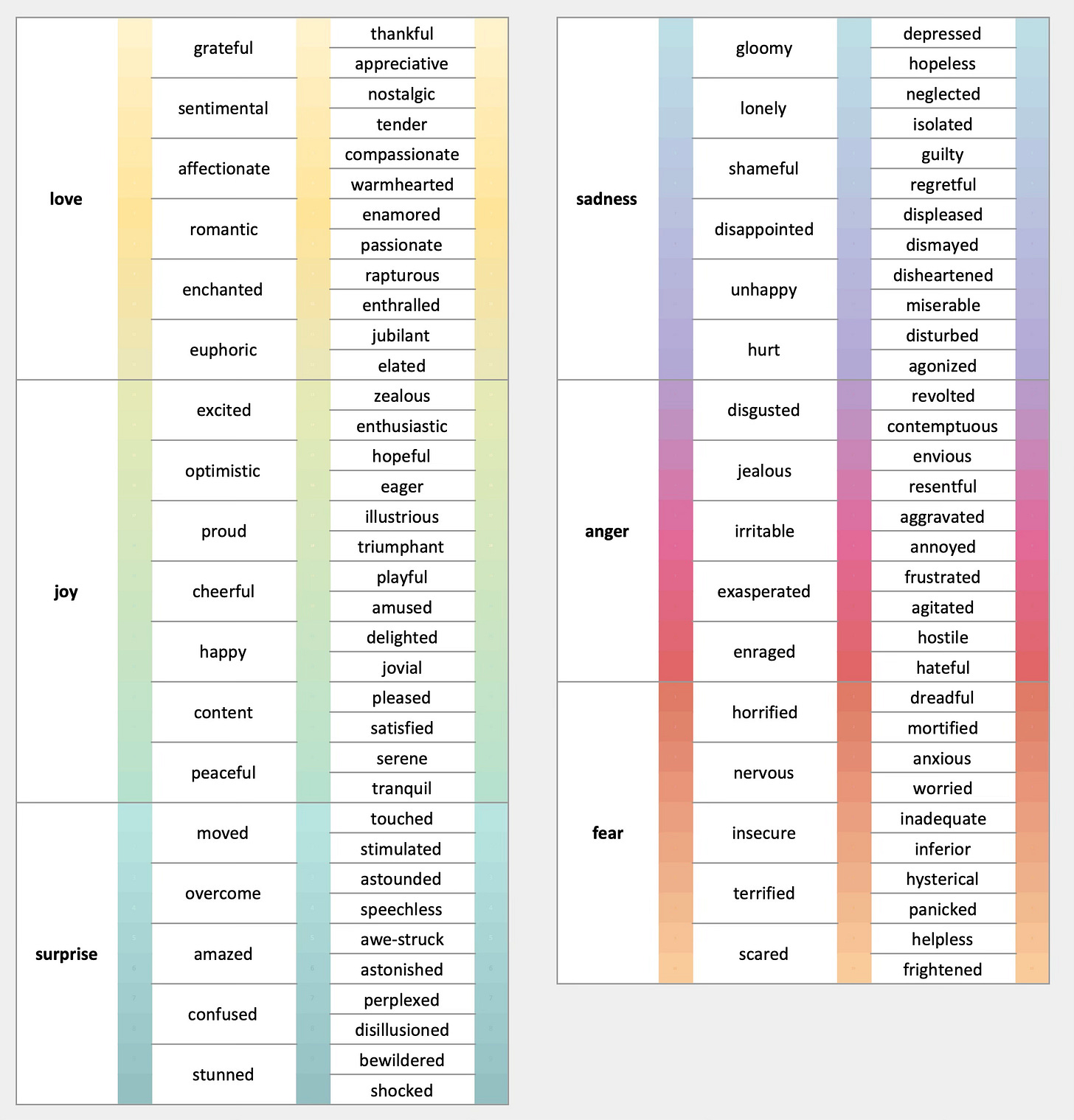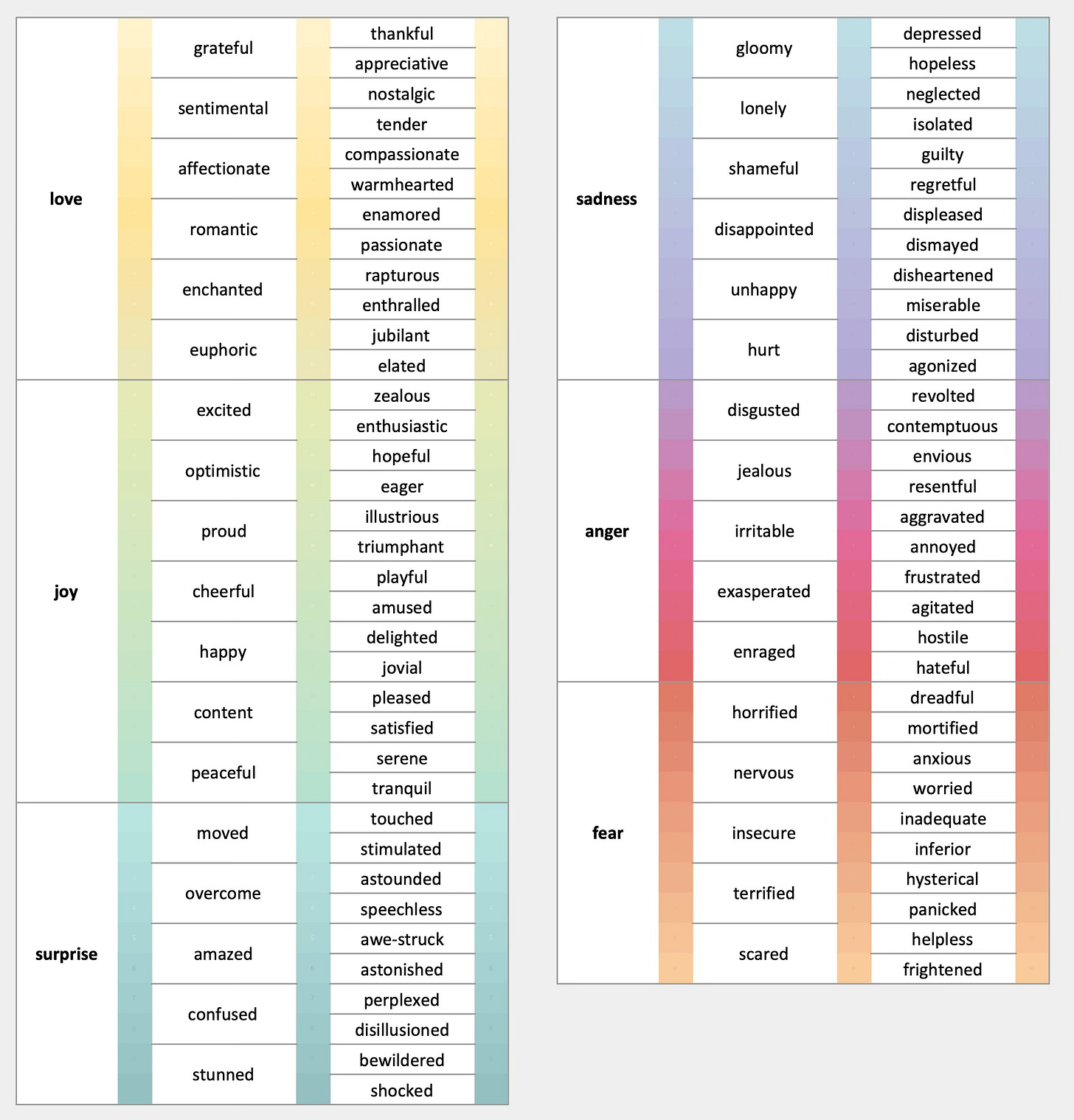Using Emotional Inquiry to develop a constructive relationship with our emotions
A simple framework to turn your emotions into practical wisdom and improved decision making.
If you like reading this article, feel free to click the ❤️ or 🔄 button on this post so more people can discover it on Substack 🙏
What is Emotional Inquiry?
Emotional Inquiry is an awareness practice. It's a simple process that helps people experience, express, and integrate their emotions in the present moment. This method is an amalgamation of mindfulness and Gestalt awareness techniques, which I use to facilitate men’s groups, coach individuals, and deepen my relationship with my emotional world.
Disclaimer: What I am suggesting below is not therapy, and I am not a therapist. These are merely practices to increase your awareness of self and others through the lens of your present moment emotional experience.
What is the purpose of Emotional Inquiry?
If we want to take full responsibility for the quality of our communication and relationships, we must be willing to feel our feelings fully. We need to build the capacity to consciously integrate our emotions into our decision-making and actions.
If we don’t consciously integrate our emotions, they tend to be expressed unconsciously, often in destructive ways. As Fritz Perls says, “What we don’t express, we suppress.”
Emotional Inquiry helps us develop a stronger and more fluid sense of self. In the process, we also gain insight into who we are, the freedom to be ourselves, and the capacity to direct our lives.
I believe that each of our emotions has wisdom and purpose; they are there for a reason. Emotional Inquiry (EI) helps us develop a constructive relationship with our emotions, allowing us to extract the valuable information they offer.
What are emotions?
To deepen our exploration and understanding of others, it's helpful to have a general understanding of the emotions we experience as humans.
My favorite definition of an emotion is simply “a state of being.” The more emotions we have in our vocabulary, the more capable we are of expressing the nuances and intricacies of ourselves and connecting deeply with others.
Here is a handy chart of emotions that I use with my clients and teams. If you are keen to develop a deeper relationship with your emotions or practice conscious communication, I recommend printing this out and placing it on your desk.
The first and most important step…get curious.
If we want to develop a healthier relationship with our emotions, it starts with getting curious. We must learn to replace the urge to distract or avoid our emotional experience with a commitment to curiosity.
Next time you find yourself in a state of TAR - tension, anxiety, or reactivity, just remind yourself to get curious.
This simple reminder will invite you to pause and look inwards to grasp the full picture of what’s going on for you.
The best questions for Emotional Inquiry
Think of Emotional Inquiry as a conversation between you and your present moment emotions. Imagine the emotion as a distinct part of yourself that you want to connect with and understand at the deepest level possible.
When you are talking to the sadness in your gut, you can speak to it as “you,” as though it were another person or entity deserving your respect.
I have compiled a list of the best questions I like to ask for Emotional Inquiry below. When we have a deeper understanding of these questions, we don’t need to think about them while engaged in a process or helping someone to explore their present moment experience. We can offer our full presence. That is why I encourage people to memorize these questions. What may start off feeling rigid and formulaic will translate into more freedom and confidence down the road.
A reporter once asked Miles Davis why he only practiced scales in his free time. Miles looked back at the reporter and said, “I practice scales so when I play to an audience, I don't think about scales.”
If you are asking someone else these questions, Gestalt practitioners like to assign specific roles to each person involved. The asker steps into the “reflector” role and offers their full presence to the “initiator” (the person speaking). Give them an opportunity to opt into the exploration, i.e., “are you open to processing now.”
Pay close attention to the body to see when it becomes activated or alive in the share. Isolating emotion as a physical sensation in the body is a direct pathway to presence. When we are connected to our body and the emotion that is present, help them to stay with it. Don’t direct it, seek to understand it, and trust that in the process, they may connect more deeply with it as well.
The best questions for Emotional Inquiry:
What do you feel in your body?
What is the emotion that is most present for you right now? Does it have a physical reference point in your body?
Can you show us where it is, touch it?
What does the emotion feel like?
How long has the emotion been there?
If that emotion had a voice, what would it say? If it made a sound, what would it sound like?
Does the emotion have a message for you?
How do you feel or how do you show up in your life when this emotion is present?
Was there a specific event that triggered this emotion?
What is behind the emotion? What is causing it?
What does the emotion need?
Are you allowing yourself to fully express this emotion fully? What would that look/feel like? What would it look like if you allowed yourself to exaggerate what it feels like?
Is there anything you would like to say to the emotion?
How can we help you to fully experience what you are feeling?
What deserves your attention now?
What are you present to now?
What would happen to the emotion and your life if you didn’t change anything?
When someone uses an adjective to describe their experience (e.g., stressful, scary, overwhelming, grateful, angry), ask them, “What does that mean to you?”
If challenging (sadness/anger/shame), what value of yours is being suppressed right now?
If uplifting (happiness/joy), what value is being expressed right now?
Is there anyone you would like to share this feeling with? What would you say?
Try to avoid questions that lead to a binary yes/no response. When we do this, we are limiting the ways the initiator can respond and restricting their freedom to express themselves.
It is also helpful to avoid “why” questions in favor of “what/how” questions. Why questions tend to lead people towards analytical processing and take them out of the experiential frame.
Questions to connect with an emotion:
If you don’t have a strong emotion present, you can prompt with these questions:
What is challenging about your current experience of life that you don’t share with others?
What is a contentious relationship in your life right now? What has been left unsaid?
What is a challenging situation you are currently engaged in?
When someone is worried about the future, ask, “What is the story you are telling yourself? What future scenario are you worried about?”
What are you currently saying about yourself to yourself? How do you get down on yourself?
What emotion has been present for you recently that deserves your attention?
Staying out of 'story'
People have a penchant for staying in story mode. These are explanations of the past, observations of other people, and predictions of the future. This is mostly counterproductive for truly processing our emotions, unless the initiator is doing it to provide important context for their share.
Again, our goal is simply to assist the initiator in exploring and expressing their present moment emotional experience.
If you notice someone or yourself "in story," gently point their awareness towards it...
“I am noticing that you are currently in story and am curious if it is important to share?”
If providing context is important to the initiator, let them share their “context” for the share. If they are not doing it intentionally, guide them back into their body and the emotions that are most present for them.
When someone is connected to their emotions and sharing transparently, you will notice a natural draw to stay in presence with them. If you notice your attention and presence wavering, check in and see if you can feel the other person connected to their experience.
Additional tips to keep someone in their emotions
If someone is connected with a specific emotion or experience, don’t ask them about another emotion or experience; help them to stay with whatever is present for them in the now.
If you feel connected to someone, share that you feel connected with them, or simply pound your chest once with a fist to show empathy.
If you do not feel connected to the initiator and their experience (they aren’t really going there), tell them you don’t feel connected to them and see what that brings up for them.
I frequently leverage two popular Gestalt-inspired techniques for Emotional Inquiry:
Open seat (based on hot seat): There are two roles, an initiator and a reflector. The initiator is the person who is opening up to an exploration of their present moment experience (thoughts/feelings/emotions). The reflector(s) is there to ask questions that take the person deeper into their exploration of their present moment experience.
The empty space (based on empty chair): We place the initiator across from an empty chair or space. He or she is asked to imagine that someone (such as a boss, spouse, or relative), they, or a part of themselves is sitting in the chair. The reflector encourages dialogue between the empty chair and initiator in order to engage the person’s thoughts, emotions, and behaviors. Sometimes the roles are reversed, and the initiator assumes the metaphorical person or part of a person in the chair. The empty chair technique can be especially useful for helping people become mindful of the whole situation and forgotten or disengaged pieces of their own self.




